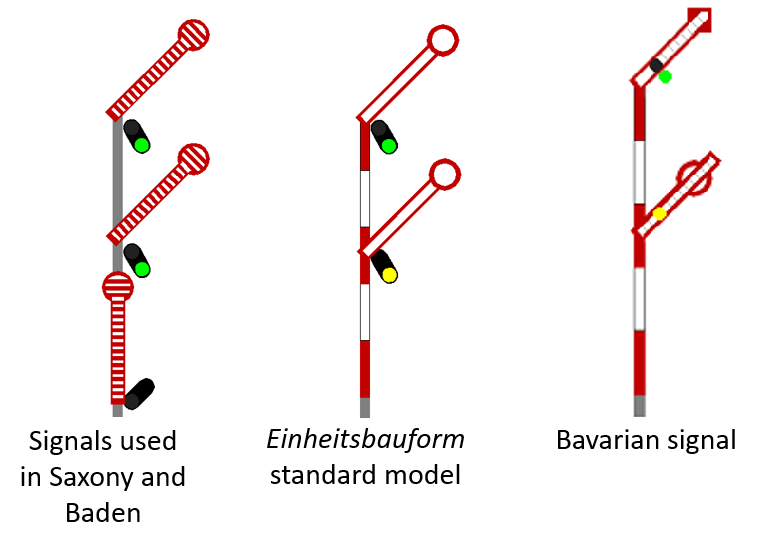
In the early days of railways, trains were few and slow, and electricity was not yet used for communications, so the operations were mostly built on the principle of audible and visible signals, and on the principle that trains used to run in specified intervals.
In Great Britain, right from the very beginning, railway lines were built to intersect other roads and paths as little as possible, while in Germany, level crossings were frequent. In 1870, level crossings in Germany at average were 625 metres apart, in Austria-Hungary 833 metres, and in England 4000 metres. So in Germany, there were frequent guard-posts which could also be used to transmit signals by optical telegraphs or other visual signals.
Some railways in the Länderbahn era had the rule that the posts had to be built so that each guard could see the adjacent guards. Messages were transmitted using a variety of devices, like baskets and balls being raised as well as semaphores and tables. Transmitting messages by optical semaphores became state of the art; in 1866 the Verein Deutscher Eisenbahnverwaltungen (Association of German Railway Administrations) recommended using semaphores for all instances of fixed signals except point signals, although until 1889 the rule book of the Großherzoglich Badische Eisenbahnen (Grand-Ducal Baden Railways) contained provisions for basket signals.
When a train left the station, the station guard raised the semaphore arm. Upon seeing this, the next guard would raise his semaphore's arm if the section under his authority was clear, and so on until the next station. So, when the driver approached a semaphore with arm raised, he could be sure that it was safe to proceed. Obviously, more than one signal aspect needed to be transmitted, such as: train coming from left / right, train coming from left / right on the wrong track, train is cancelled, an assisting loco is required from left / right, the assisting loco shall return, etc.. Every railway administration used their own signals, so in 1867 there were 166 different forms for these signals.
Note: German railways use right-hand running, so the expression wrong track means the counter track which usually is the left one.
The trains could be used to transmit messages to the guards, too, by using differently coloured lanterns or flags for messages such as: an extra train follows, an extra train comes in the counter direction, train is running on the wrong track, train is returning, order to revise the track, etc.
We can see that messages need to be transmitted to two very different groups of recipients, and for very different purposes:
For the former messages, fixed signals like semaphores or boards became commonplace, while for the latter ones, telegraphs and bells came into use.
As my web site focuses on the lineside signals, I will not cover the bell signals and telegraphs here.
After some development, most of railway administration introduced semaphore signals to indicate whether a train may proceed or must stop. In Germany, we call these signals Flügelsignale ("wing signals"), for they have arms (in Germany, we call them Flügel - wings), which can be turned into various positions.
Even though some countries (like France, Belgium, Netherlands, Italy, follow more closely the British model, while Scandinavia, Poland, the Balkan countries and Russia follow more closely the German model, there are only few railways which used signals other than semaphores. One example is France, which used a square board (carré) to indicate an absolute stop. Other differences are whether the semaphore arm is raised or lowered to indicate to the train driver that he may proceed, but all in railways, a horizontal arm means stop.
In the Länderbahn era (Epoch I), the semaphore signals in the different German states already looked similar, but they were not yet the same.
 |
Länderbahn signals were already similar in appearance, but due to different suppliers and standards there were still differences. |
A further development was triggered by several factors:
The German railways did the first test installation of colour light signals in 1928 on the line between Hirschberg and Königszelt in Silesia (the area now belongs to Poland, and the cities are named Jelenia Góra and Jaworzyna Śląska). The tests were very successful, since 1959, no new semaphores have been installed, though some are still in operation. Position light signals, as they are used by some US American railways, have never been used in Germany (except for some shunting signals like Ra 6...9)
Another important aspect were the colours which were used to indicate the signal aspect at night (or later, as the electric colour-light signals displayed the night aspects of the semaphore signals, this concerned the aspects of the colour light signals, too).
When colours were used at first, it seemed natural to use an unfiltered light (i.e. white) to indicate an uninhibited aspect (i.e., clear), and to use a light filtered by a tinted glass to indicate aspects like caution, slow, or stop.
The first signal lanterns were illuminated by paraffin lamps which emitted a yellowish light, so yellow and white would not have been easy to distinguish, and anyway glassmakers were not able to make suitable yellow glass, but red and green were possible.
So the first colours and their meaning was:
 home home |
 German
railway history German
railway history |
 email email |
 history of railways in Germany
history of railways in Germany |
 history of German
interlockings history of German
interlockings |